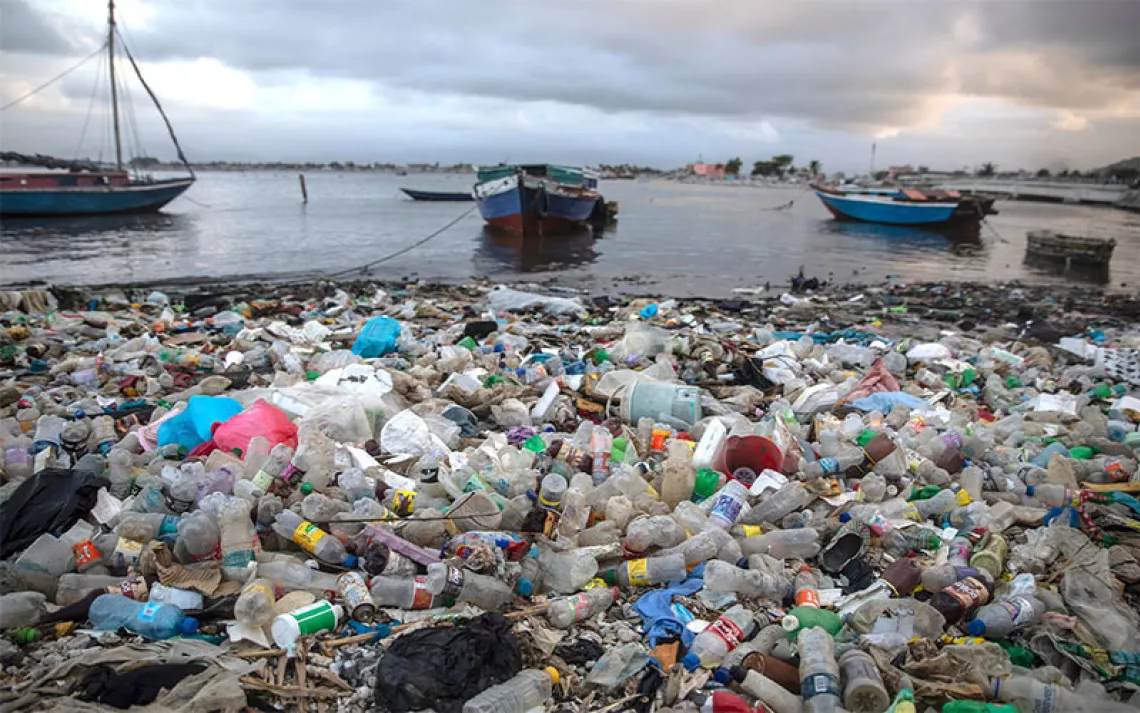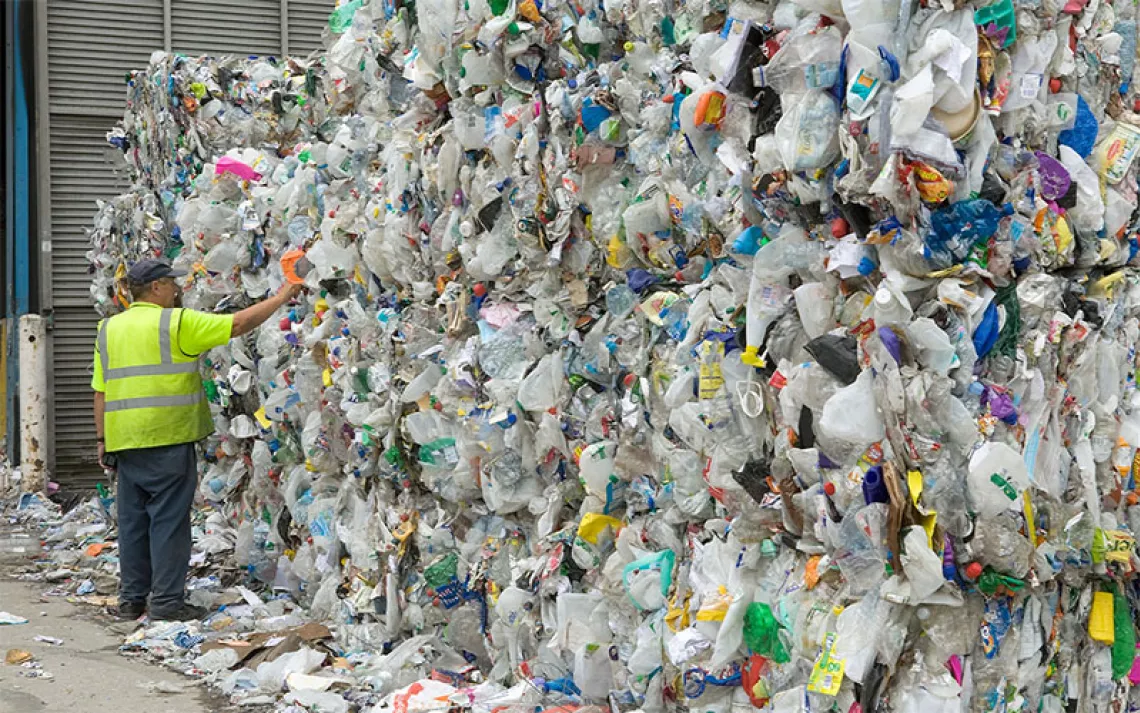Boom Goes the Plastics Industry
With demand for oil expected to slow, oil companies seek a lifeline in plastics

A March explosion at a Houston-area petrochemical plant released tens of millions of pounds of pollutants. | Photo by Elizabeth Conley/Houston Chronicle/AP
Early in the morning on Sunday, March 17, Terri Garcia picked up the phone to a frantic barrage of questions from her mother: "Where are my grandbabies? Where's your brother? What are your nephews doing?" Garcia had no idea what had upset her mother until she looked out her back window and saw a column of black smoke rising from one of the numerous fossil fuel facilities near her home in Deer Park, 15 miles southeast of Houston.
A leaking pipe at a Mitsui & Co. Intercontinental Terminals Company facility five miles from Garcia's house had sparked a fire in one of the nearly 250 massive tanks that hold as much as 3.3 million gallons of petrochemicals apiece. The fire quickly spread, releasing 6 million pounds of pollutants in the first 24 hours. The fire continued on and off for five days, releasing cancer-causing benzene. On the third day, Garcia's daughter and her classmates could see the flames burn and the black smoke stretch overhead from the second-story window of their elementary school. When nearby resident and mother of four Sema Hernandez came to the school, "it looked like the entrance to hell," she said.
Mitsui & Co. stores highly toxic byproducts of the oil-refining process for clients including ExxonMobil, Chevron, and Phillips 66. The petrochemicals burned in the fire included naphtha, xylene, and toluene. They are not exactly household names, but among their uses is the manufacture of plastics: These fossil fuel derivatives are the cornerstones of the excessive plastic packaging that encases our water, fruits and vegetables, granola bars, and toiletries.
Facing intensifying global efforts to curtail the use of oil and gas for transportation and energy—and at the same time seeking markets for the torrent of oil and gas from the US fracking boom—the fossil fuel industry is looking to plastics as a lifeline. Today, 14 percent of oil and 8 percent of gas is used for the manufacture of petrochemicals, the essential feedstock of plastic production. The International Energy Agency predicts that by 2050, 50 percent of the growth in oil demand will be related to petrochemicals, overtaking the oil-demand growth related to automobile transportation.
ExxonMobil and Saudi Aramco, among the world's largest fossil fuel companies, are betting big on plastics. In its latest investor report, ExxonMobil acknowledged a sharp decline in demand for gasoline. The company expects it will help fill the gap with chemicals and predicts a 30 percent increase in demand by 2025. A recent investor article released by Bank of America Merrill Lynch was titled "Oil's Future Paved With Plastic."
This pivot is already well underway. The excess of oil and gas has contributed to a frenzy of pipeline construction geared toward shipping ever greater quantities of fossil fuels to the coasts, where facilities distill the chemical building blocks needed for plastic production. The American Chemistry Council reports that since 2010, plans for 333 new chemical-manufacturing projects have been announced in the United States, representing more than $200 billion in capital investments; the industry association notes that "much of the investment is geared toward export markets for chemistry and plastics products." A great deal of the build-out is along the Gulf Coast, led by Chevron, Phillips 66, and ExxonMobil. Shell Oil and other companies are building chemical-production capacity on the East Coast and along the Ohio River in Pennsylvania and Ohio.
The result of this increased production is that it is now cheaper than ever to produce single-use plastic for consumer packaging—the number one end use of plastic. Yet while plastics is surging, popular concern about the impacts of plastic pollution is mounting. In response to this movement, ExxonMobil, Shell, and Dow Chemical recently formed the Alliance to End Plastic Waste, to help "end the flow of plastic waste into the environment."
Carroll Muffett, president of the Center for International Environmental Law, sees this as a blatant attempt to distract the public and deter efforts to restrict or regulate the means of fossil fuel and plastic production. The fossil fuel industry "has been very effective at shifting the narrative from production to the end of the plastic life cycle," he argues. "By focusing on plastics as a waste-management and marine-litter problem, the industry makes its own contributions to the plastic crisis invisible." In February, CIEL released an 80-page report identifying a human "health crisis," including increased risks of cancer, stemming from harms presented at every stage of plastic production, consumption, and disposal.
"Plastics are not just harmful to sea creatures and waterways," says Priscilla Villa, a Texas-based organizer for the watchdog group Earthworks. She says the chemical-plant build-out in Texas and Louisiana shows a "blatant disregard for the people who have to live near these facilities and the type of risk they have to face to their health, safety, and environment."
In their homes near Houston, Garcia and Hernandez think about their children and the potential long-term health impacts of the Mitsui & Co. petrochemical fire—just one of countless daily pollution events caused by the industry—and neither can control her tears. They cannot afford to move, nor do they want to, as they love their communities. "They're the ones creating the pollution," Hernandez says of the fossil fuel companies. "Why shouldn't they be forced to leave?"
This article appeared in the July/August 2019 edition with the headline "Boom Goes the Plastics Industry."
 The Magazine of The Sierra Club
The Magazine of The Sierra Club



